| Pages:
1
2 |
The Volatile Chemist
International Hazard
    
Posts: 1981
Registered: 22-3-2014
Location: 'Stil' in the lab...
Member Is Offline
Mood: Copious
|
|
Quote: Originally posted by Oscilllator  |
Errr...
That green stuff? Thats the picture.
I'll try isolating the white precipitate and analysing that. We'll see what we can get. |
Oh! Now we're getting someplace! The blue almost has to be Iron, likely oxidized to (III) since you used ferrocyanide, and not
ferricyanide. The green color could be the Prussian blue (the blue stuff, if it was iron related) being turned into a cyanide of sorts because of
whatever ion was attached to the compound, but I think not. I think it's either a mix of lots of metal ions all with the same cation (in short,
someone's waste, 2nd most likely), or a single compound with iron impurities. The impurities caused the blue, and the actual metal
ion caused the green. This would also make sense if the compound is a chloride, as HCl usually has Iron(III) impurities in it. I'd bet $10 on that
last one, it fits the most evidence.
|
|
|
Oscilllator
National Hazard
   
Posts: 659
Registered: 8-10-2012
Location: The aqueous layer
Member Is Offline
Mood: No Mood
|
|
I'll try adding plain ferrocyanide to my HCl to see if I get a blue colour. I'll also conduct more tests to see if the yellow colour is caused by the
addition of HCl, and as well as that I'll conduct tests with the ferrocyanide on some known compound I have (FeSO4 being among them).
Perhaps isolating the precipitate from the addition of carbonate as Random suggested and testing that will yield some better results.
|
|
|
The Volatile Chemist
International Hazard
    
Posts: 1981
Registered: 22-3-2014
Location: 'Stil' in the lab...
Member Is Offline
Mood: Copious
|
|
Quote: Originally posted by Oscilllator  | I'll try adding plain ferrocyanide to my HCl to see if I get a blue colour. I'll also conduct more tests to see if the yellow colour is caused by the
addition of HCl, and as well as that I'll conduct tests with the ferrocyanide on some known compound I have (FeSO4 being among them).
Perhaps isolating the precipitate from the addition of carbonate as Random suggested and testing that will yield some better results.
|
DON'T DO IT!!!!!!!!!!!!!!!!!!!!!!!!!!!!!!!!!!!!
That would produce HCN gas!!!!!!!!!!!!!!!
I'm kinda hoping you don't try it..............
Evaporate a sample of HCl, dilute residue, then add ferrocyanide.
|
|
|
Oscilllator
National Hazard
   
Posts: 659
Registered: 8-10-2012
Location: The aqueous layer
Member Is Offline
Mood: No Mood
|
|
If I remember correctly from the cyanide preparation thread it shouldn't produce much cyanide gas unless heated, but your way sounds much safer so
I'll do it that way.
|
|
|
The Volatile Chemist
International Hazard
    
Posts: 1981
Registered: 22-3-2014
Location: 'Stil' in the lab...
Member Is Offline
Mood: Copious
|
|
Quote: Originally posted by Oscilllator  |
If I remember correctly from the cyanide preparation thread it shouldn't produce much cyanide gas unless heated, but your way sounds much safer so
I'll do it that way. |
Good. I'm curious as to what it will show.
|
|
|
sulfuric acid is the king
Hazard to Self
 
Posts: 94
Registered: 11-1-2017
Member Is Offline
|
|
I needed some iron sulfate so i disolved scrap from scrapyard.
Few such metal sheet triangles (probably after some cutting process) disolved in 250ml Erlenmeyer gave such mass.
It broke my flask unfortunately when i tried to crush it with something.
It was insoluble even in boiling solution of iron sulfate/sulfuric acid.
So what can it be?
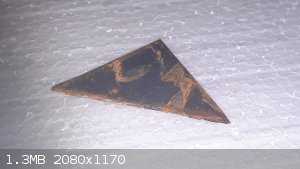 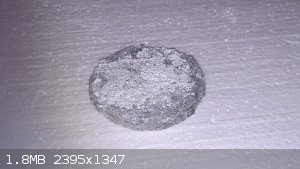
|
|
|
bnull
Hazard to Others
  
Posts: 148
Registered: 15-1-2024
Location: Between the Atlantic and the Pacific Ocean
Member Is Offline
Mood: Feeling like a pinky-bending bluesman.
|
|
It's hard to say just by looking. I have some suggestions that may make it easier to identify the substance.
Could you please describe in details the procedure you employed? How did you get the grey pancake? Was it by boiling to dryness?
Could you try one or more of the following:
Dissolve a fragment in ammonium hydroxide;
Dissolve a fragment in a concentrated solution of sodium hydroxide;
Dissolve a fragment in hydrochloric acid;
Melt a fragment in a crucible.
If you still have some triangles left, could you please sandpaper one of them and test the powdered stuff as in (2)?
If I were to guess--and it's a very wild guess--, I'd say it is lead(IV) oxide, produced by the reaction of sulfuric acid and the dark paint on the
surface of the triangle. It is very similar to one of those old rustproof primers based on lead(II,IV) oxide. When attacked by acids, lead(II) oxide
is dissolved and lead(IV) remains, although in this instance the insoluble lead(II) sulfate would also deposit.
Quod scripsi, scripsi.
B. N. Ull
|
|
|
sulfuric acid is the king
Hazard to Self
 
Posts: 94
Registered: 11-1-2017
Member Is Offline
|
|
I think it's definitely not from the paint beacause the quantity was much higher, and there was no paint on that steel as you can see, it's natural
gray colour of the steel.
I just put 33 percent sulfuric acid and added that triangles, it was made in the process (gray cake), after everything cooled next day i had green
crystals of iron sulfate, black stuff around (probably carbon from the steel) and that unsoluble cake at the bottom.
When i wash cake and add tap water (mine is chlorinated) interesting thing happens.
It seems that cake is slightly soluble. Water first becomes milky and then it gets red-yellowish colour, little bit like rust.
Also when i slowly shake it seems like i have 2 separate liquid layers, oily like at the bottom and that rusty above, but it's probably just density
difference.
All this is from simple steel cuts, i don't think it's possible to make some alloy with such large proportion of lead in it, but i don't know really.
Thanks for suggestions i'll try some of them.
|
|
|
sulfuric acid is the king
Hazard to Self
 
Posts: 94
Registered: 11-1-2017
Member Is Offline
|
|
That relatively unsoluble, white-grayish stuff from the picture above:
1.Few hours in tap water
2.Immidiate raction with 10% NaOH. (deep green precipitate)
3.Extremely slow reaction with 16% HCl. (it tends towards yellow-green)
So mistery compound is some iron hydroxide?
How can it be formed together with sulfate at the same time?
Interesting
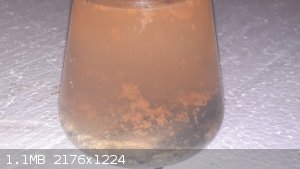 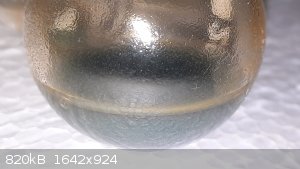 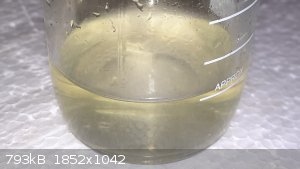
|
|
|
bnull
Hazard to Others
  
Posts: 148
Registered: 15-1-2024
Location: Between the Atlantic and the Pacific Ocean
Member Is Offline
Mood: Feeling like a pinky-bending bluesman.
|
|
Quote: Originally posted by sulfuric acid is the king  | That relatively unsoluble, white-grayish stuff from the picture above:
1.Few hours in tap water
2.Immidiate raction with 10% NaOH. (deep green precipitate)
3.Extremely slow reaction with 16% HCl. (it tends towards yellow-green)
[...] Interesting
|
It is really interesting. It seems that the triangles were plain carbon steel; the orange smudges shown in the picture must be rust, so there was no
lead paint. And iron doesn't alloy with lead. The cake seems to be a mixture of iron oxides and hydroxides, iron(II) sulfate, and maybe even iron
powderNote 1. This explains the partial solubility and the green precipitate in the reaction with NaOH.
Probably. If you add hypochlorite or hydrogen peroxide to the green precipitate, it will get brown or orange if it's iron(II) hydroxide. There's a
table here that may help you confirm the identity: https://www.docbrown.info/page07/appendixtrans12.htm.
PerhapsNote 2 by the sequence of reactions below:
Iron is dissolved by sulfuric acid:$$Fe(s)+2H^+(aq) \rightarrow Fe^{2+}(aq)+H_2(g)$$
It reacts with the air dissolved in the solution and is oxidised:$$4Fe^{2+}(aq)+O_2(aq)+4H^+(aq) \rightarrow 4Fe^{3+}(aq)+2H_2O(l)$$
The ferric ion attacks the solid metal:$$2Fe^{3+}(aq)+Fe(s) \rightarrow 3Fe^{2+}(aq)$$
If there's an excess of solid iron, as it seems the case, the metal that is attacked in step 3 will end up reacting with the oxygen dissolved
and the water, forming oxides and hydroxidesNote 3:$$Fe^{2+}(aq)+O_2(aq)+H_2O(l) \rightarrow Fe(OH)_2(s)+Fe_2O_3(s)+FeO(OH)_2\cdot
nH_2O(s)+other~stuff$$
The reactions stop when there is no more acid and oxygen to react with the iron.
Note 1: Maybe not exactly iron powder. Some iron carbide, silicon perhaps, iron phosphides/phosphates
(I don't know which) maybe, and manganese carbide. Every carbon steel has some manganese in it.
Note 2: The electrochemical potentials are favorable.
Note 3: The equation is unbalanced because the composition is unknown. Well, at least unknown to me.
Quod scripsi, scripsi.
B. N. Ull
|
|
|
sulfuric acid is the king
Hazard to Self
 
Posts: 94
Registered: 11-1-2017
Member Is Offline
|
|
And exactly that happened, mistery solved, thanks
|
|
|
| Pages:
1
2 |